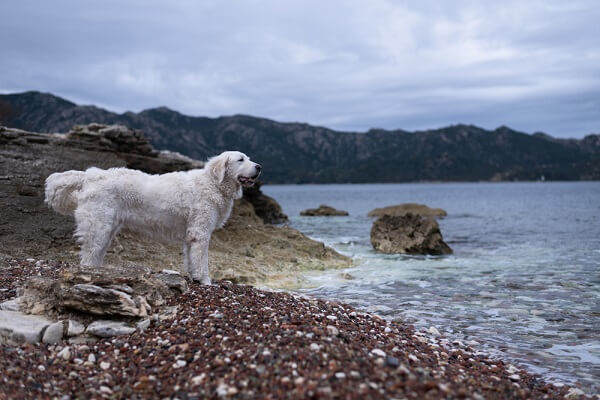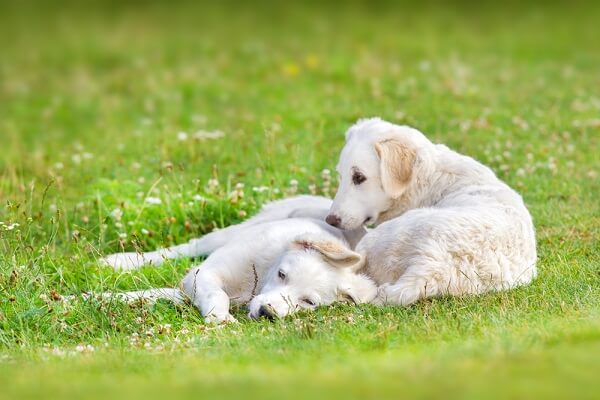
The Kuvasz is a breed of dog that was selected to guard livestock. However, its friendliness, loyal nature, and territoriality make it an excellent family guard dog. Pronounced “Coo-Vahs,” this breed originated in Hungary and is often confused with the Great Pyrenees. Kuvasz puppies can be quite expensive, though there are several Kuvasz rescues that specialize in the breed. Because the Kuvasz was bred as a guard dog, it is recommended to begin obedience and socialization training very early on to ensure that the Kuvasz is friendly as it grows older. Sometimes the breed is considered “aloof,” though this is most often attributed to its habit of observing for threats while the “flock” continues grazing. Introducing your Kuvasz to new dogs and small animals should be monitored carefully because this breed was selected for generations on its ability to kill smaller canines like coyotes and foxes. It may recognize other dogs as a threat, unless it is well socialized as a puppy. Though these two breeds are very similar at a quick glance, they have quite a few differences that make them clearly distinguishable from each other. In general, the Kuvasz is taller, thinner, and more athletic. The Great Pyrenees tend to be much thicker and more lumbering. Further, the Kuvasz makes a much better family dog. The Pyrenees tend to chase off predators well, but often take their job a little too seriously and end up lost. By contrast, the Kuvasz makes an excellent guard dog – but rarely wanders too far from home. There are also some physical traits that can help you tell the two breeds apart. The Kuvasz has a single dewclaw, whereas the Great Pyrenees has two. The head of the Great Pyrenees is very wide and blocky, whereas the Kuvasz has a narrow snout. The Kuvasz is usually completely white (ivory), but the Great Pyrenees often have grey or beige markings that break up the coat color. While the Kuvasz is a loyal guard dog and fun family pet, few owners are aware of how much this breed can teach us about biology in general. These fun facts show the many deep connections the Kuvasz has to important biological concepts! Like many other good guard dogs, this breed is part of the “Working Group” of dog breeds. These breeds, though they originated from wolves, have been selected for generations for their ability to stop wolves from killing livestock. Amazingly, this ability stems from the same behavioral adaptations that keep wolves together in packs. A wolf pack is like a rigorously structured family – the Alpha Male and Female control the pack and direct the actions of the younger individuals. Through this familial bond, the wolves protect one another as a unit from much larger predators like bears, cougars, and even humans. But, when you take a wolf as a pup and introduce it to an entirely new social structure, it can identify with that group as its “pack.” While domesticated dogs no longer subscribe to the rigorous social structure of a “pack,” many breeds like the Kuvasz are still subject to the same defensive impulses that the pack uses to protect its most vulnerable members. Shepherds that need help defending their flock will often adopt a young Kuvasz as a young puppy. Instead of becoming bonded with a family of other dogs, the young Kuvasz will accept the flock (of sheep or other livestock) as its pack and will defend them with vigor as it grows older. This is true of many Working Dog breeds – and this behavior is an evolutionary leftover from wolf behaviors! The Kuvasz has a very interesting history – one in which it almost disappeared entirely. Though the breed likely originated in Tibet and even ancient Mesopotamia, the breed got its distinguishing characteristics in Hungary during the late 1600s, when they were bred as royal guard dogs. The King of Hungary at the time would give the dogs away to noble families, where they begin to spread across Hungary. By the time World War II swept across Europe, the Kuvasz was actually a fairly common guard dog in the rural countryside. However, because they are such great guard dogs, they were often targeted by Nazi soldiers moving through the territory. By the end of the war, there were only 30 individuals left in the entire country. Like many animals, the war pushed them to the edge of extinction. Though they have made a considerable comeback since the end of the war due to the efforts of dedicated breeders.
Kingdom
Animalia
Phylum
Chordata
Class
Mammalia
Order
Carnivora
Family
Canidae
Genus
Canis
Species
Canis familiaris
Niche
Domesticated
Height
26-30 in (66-76 cm)
Weight
70-115 lbs (31-52 kg)
Lifespan
10-12 years
Social Structure
Domesticated
Conservation Status
Least Concern
Preferred Habitat
Domestic, often a guard dog
Average Litter Size
6-8 puppies
Main Prey Species
Dog Food
Predators
Few Predators
The Basics

The Kuvasz vs The Great Pyrenees

Fun Facts about the Kuvasz!
From Predator to Defender

Dog Breeds can go Extinct, too!

